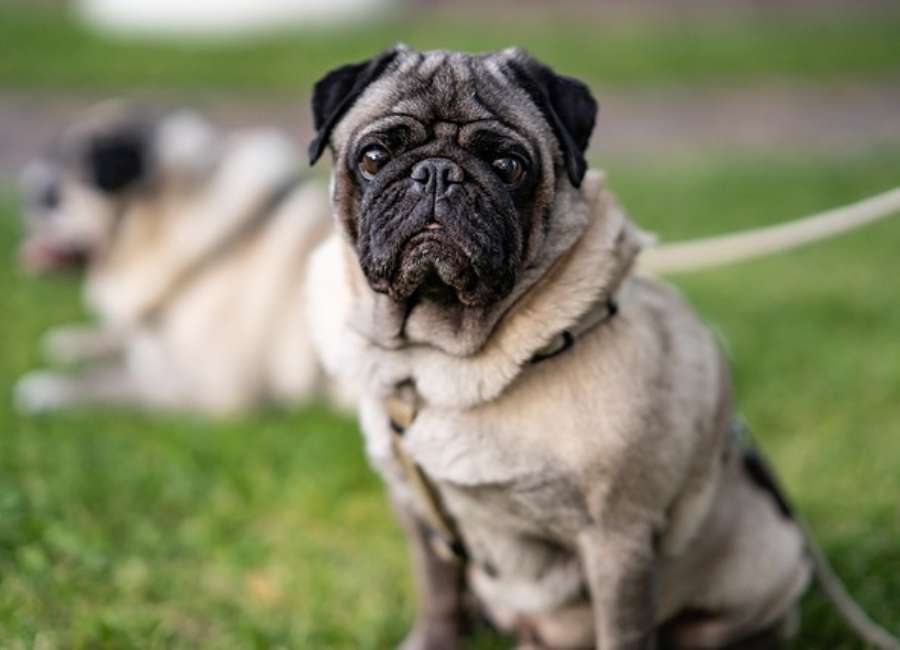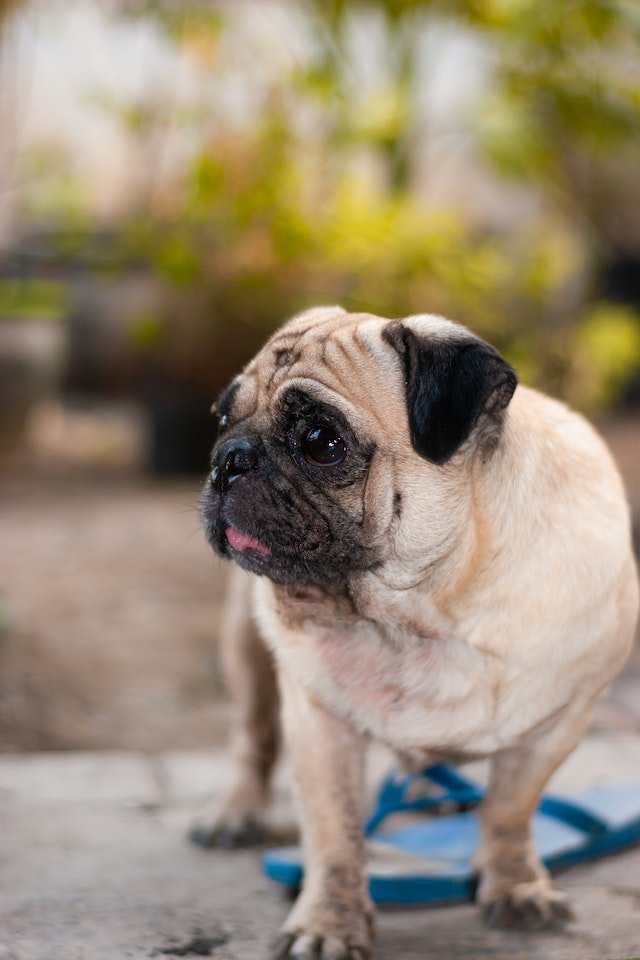Dealing With Pug Skin Problems & Care

Pug skin is unique and requires specific attention to keep it clean, moisturized, and free from common issues.
In this comprehensive guide, we will delve into the world of Pug skin care and provide you with advice, tips, and remedies to ensure your Pug has healthy and vibrant skin.
Understanding Pug Skin
Pug skin is delicate and prone to certain issues due to its specific characteristics. Pugs have short, fine hair and folds on their faces, which can trap moisture, dirt, and debris.
These factors make them susceptible to skin irritations, infections, and allergies. Additionally, pugs have thin skin, which is more prone to damage and injuries.
Common Skin Issues in Pugs
Pugs are at high risk of developing various health issues due to their distinctive characteristics, and skin problems are one of the most common issues.
Here are some common skin issues that affect pugs.
1. Skin Allergies: Pugs are prone to allergies, and these allergies can manifest in various ways, such as skin irritation, rashes, and coughing. The main culprits are environmental allergens, food allergens, and flea allergy dermatitis.
Learn more about pug skin allergies.
2. Bacterial Skin Infections: Bacterial infections are common in pugs due to the folds of their skin, which can trap moisture and bacteria. These infections can cause itching, redness, and hair loss.
3. Yeast Infections: Pugs are also susceptible to yeast infections, which can occur anywhere on the body but commonly affect their ears or paw pads. These infections can cause a foul odor, redness, and discharge.
4. Acne: Pugs can develop acne due to the folds of their skin, which can trap dirt and oil. Acne can lead to inflammation, redness, and discomfort.
5. Mange: Pugs can contract sarcoptic mange or demodectic mange, which are caused by mites. These parasitic infections can cause itching, scabs, and hair loss.
6. Hot Spots: Hot spots are moist and infected patches on the skin that can be caused by a variety of factors, such as allergies, parasites, or trauma.
7. Ringworm: Ringworm is a fungal infection that can cause circular patches of hair loss and scaly skin. It can spread to other pets and humans, so prompt treatment is necessary.
8. Skin Cancer: Pugs are also prone to skin cancer, especially in light-colored areas of the skin exposed to the sun. Early detection and treatment are essential.
9. Wrinkle Dermatitis: Pug wrinkles can be a breeding ground for bacteria and yeast, leading to redness, inflammation, and infection.
10. Interdigital Cysts: Pugs can develop cysts between their toes, causing discomfort and sometimes requiring medical intervention.
Pug Skin Care

Pugs are known for their adorable wrinkly faces and unique skin folds, but these features also require extra attention to maintain good skin health.
Here are some tips for pug skin care:
1. Regular Brushing
Keeping your pug’s skin clean is crucial for preventing irritation and infections. Gently brush their coat at least once a week using a soft bristle brush or a grooming mitt.
Regular brushing not only removes loose hair but also stimulates blood circulation and distributes natural oils, promoting a healthy skin and coat.
2. Bathing
Pugs should be bathed every 4–6 weeks or as needed. Use a gentle, pH-balanced dog shampoo recommended by your veterinarian. Avoid over-bathing, as it can strip the skin of essential oils, leading to dryness and itching.
Remember to dry your pug thoroughly, paying extra attention to the folds of their skin, to prevent moisture-related issues.
3. Wrinkle Cleaning
Those adorable pug wrinkles are undeniably charming, but they require special care. Moisture, dirt, and bacteria can accumulate in these folds, potentially leading to infections.
Regularly clean the wrinkles using a soft cloth or a pet-safe wipe. Be gentle yet thorough, ensuring you reach all the crevices. Consider using a veterinarian-approved wrinkle cream to help maintain cleanliness and prevent discomfort.
4. Moisturizing
Pug skin tends to be dry, so it’s important to keep it moisturized. Consult your veterinarian to find a suitable, hypoallergenic moisturizer designed specifically for dogs.
Apply a small amount to your pug’s skin, paying attention to areas prone to dryness, such as the elbows and nose. Regular moisturizing helps prevent itchiness and flakiness, promoting a supple and healthy skin.
5. Sun Protection
Pugs have thin, delicate skin that can easily burn in the sun. Protect your pug from harmful UV rays by limiting their sun exposure, especially during peak hours.
If your pug enjoys spending time outdoors, consider using a dog-specific sunscreen on their exposed areas, such as the nose and ears. Additionally, providing shade and keeping them well-hydrated is essential to prevent overheating and sunstroke.
6. Proper Nutrition
A well-balanced diet plays a crucial role in maintaining healthy skin for your pug. Opt for high-quality dog food that contains essential nutrients like omega-3 fatty acids, which promote healthy skin and a shiny coat.
Consult your veterinarian to determine the most suitable diet for your pug’s specific needs, as individual requirements may vary.
7. Allergen Management
Pugs are prone to allergies, which can manifest as itchy skin, rashes, or other discomfort. Identify and manage potential allergens in your pug’s environment, such as certain foods, pollen, dust mites, or chemicals.
Your veterinarian can help you identify the triggers and suggest appropriate dietary adjustments or allergy medications to alleviate any discomfort.
8. Hydration
Proper hydration is essential for maintaining healthy skin. Ensure your pug has access to fresh, clean water at all times.
Dehydration can lead to dry skin, so encourage your pug to drink water regularly, especially during hot weather or after physical activity. If you notice any signs of dehydration, such as dry gums or excessive panting, contact your veterinarian promptly.
9. Regular Veterinary Check-ups
Routine visits to the veterinarian are vital for your pug’s overall health, including their skin. Regular check-ups allow the vet to monitor your pug’s skin condition, address any concerns, and provide preventive treatments if necessary. They can also recommend specific products or treatments tailored to your pug’s unique needs.
Learn more about caring for senior pugs.
Preventing pug skin issues
Pugs are prone to a variety of skin issues, but there are things you can do to help prevent these problems. Here are some ways you can help keep your Pug’s skin healthy:
1. Regular Grooming and Bathing: Regular grooming and bathing are essential to help remove potential irritants, dirt, and bacteria that can lead to skin infections.
2. Balanced Diet: Feeding your Pug a high-quality balanced diet will provide them with the nutrients they need for healthy skin. You may also consider adding fish oil supplements to their diet.
3. Flea and Tick Prevention: Regularly giving flea and tick preventatives can help to prevent skin issues caused by these parasites.
4. Regular Exercise: Regular exercise helps keep a Pug’s weight at a healthy level, which can decrease the likelihood of skin problems.
5. Keep the Skin Dry: Damp skin provides the perfect environment for fungal and bacterial growth. Ensure your Pug’s skin is dry after bathing or playing in water.
6. Provide Shade and Avoid Overheating: Pugs can easily become overheated and develop skin rashes or infections as a result. Provide them with shade during hot weather and avoid excessive exercise in the heat.
7. Watch for Allergies: Keep an eye out for any signs of allergies that can lead to skin irritation or infections. A veterinarian can help you identify potential allergens and develop strategies to manage them.
8. Regular Veterinary Check-ups: Regular vet check-ups can help identify and address any potential skin issues before they become major problems.
Pug Skin Infections

Pugs are susceptible to bacterial and viral skin infections, as well as other skin conditions. Two common skin infections that can affect pugs are yeast dermatitis and mast cell tumors.
Causes and Symptoms
Yeast dermatitis is caused by an overgrowth of yeast on the skin. Symptoms include itching, redness, and a greasy or flaky appearance of the affected area.
Mast cell tumors, on the other hand, are cancerous growths that can appear anywhere on the skin. Symptoms include lumps or bumps on the skin, as well as inflammation and itchiness.
Prevention
Preventing skin infections in pugs involves regular grooming and cleaning. Pugs should be given frequent baths with gentle shampoo to prevent the buildup of bacteria and yeast. Cleaning their wrinkles is also important, as dirt and moisture can become trapped in the folds of their skin and lead to infection.
Treatment
Treatment for skin infections in pugs will depend on the specific type of infection. Yeast dermatitis may be treated with antifungal medications or medicated shampoos, while mast cell tumors may require surgical removal. It’s important to consult with a veterinarian for proper diagnosis and treatment of any skin infections in pugs.
Importance of Exercise for Pug Skin Health
Regular exercise is beneficial for your pug’s overall well-being, including their skin health. Engaging in physical activities helps improve blood circulation, which nourishes the skin and promotes a healthy coat. Ensure your pug gets daily exercise through walks, playtime, or interactive toys.
The Role of Supplements in Pug Skin Care
Certain supplements can support your pug’s skin health. Consult with your veterinarian about the following options:
- Omega-3 fatty acids reduce inflammation and improve skin moisture.
- Probiotics support a healthy immune system and digestive function.
- Antioxidants combat free radicals and promote overall skin health.
Always follow your veterinarian’s recommendations regarding supplements for your pug.
Treating Skin Conditions in Pugs
When your pug experiences a skin condition, prompt and appropriate treatment is crucial. Treatment options may include:
- Topical medications to alleviate symptoms and combat infections.
- Oral medications are prescribed by a veterinarian for more severe skin conditions.
- Specialized shampoos or sprays to target specific skin issues.
- Allergy management through elimination diets, antihistamines, or immunotherapy.
Always follow your veterinarian’s advice and instructions when treating your pug’s skin conditions.
Related Questions
How often should I bathe my pug?
Pugs typically require bathing every 4 to 6 weeks. However, if your pug gets dirty or develops a specific skin condition, you may need to bathe them more frequently. Consult your veterinarian for individual recommendations.
Can I use human skincare products on my pug?
No, it’s not recommended. Human skincare products can contain ingredients that are harmful to dogs. Always choose products specifically formulated for dogs to ensure their safety and effectiveness.
Are pugs more prone to skin allergies compared to other breeds?
Yes, pugs have a higher likelihood of developing skin allergies due to their genetic predisposition. Proper care, regular grooming, and a healthy diet can help manage and reduce the risk of allergies.
How can I prevent wrinkles from becoming infected in my pug?
Clean and dry your pug’s wrinkles regularly using a gentle cleanser recommended by your veterinarian. Ensure you dry the wrinkles thoroughly after cleaning to prevent moisture-related infections.
Can stress affect my pug’s skin health?
Yes, stress can impact your pug’s overall health, including their skin. Maintaining a stress-free environment and providing mental stimulation can help promote healthy skin and well-being.
Conclusion
Caring for your Pug’s skin is an essential part of being a responsible pet owner.
By understanding common skin issues, implementing proper grooming techniques, and following expert advice, you can ensure your Pug’s skin remains healthy, vibrant, and free from discomfort.
Remember to consult with a veterinarian for any specific concerns regarding your Pug’s skin health.
